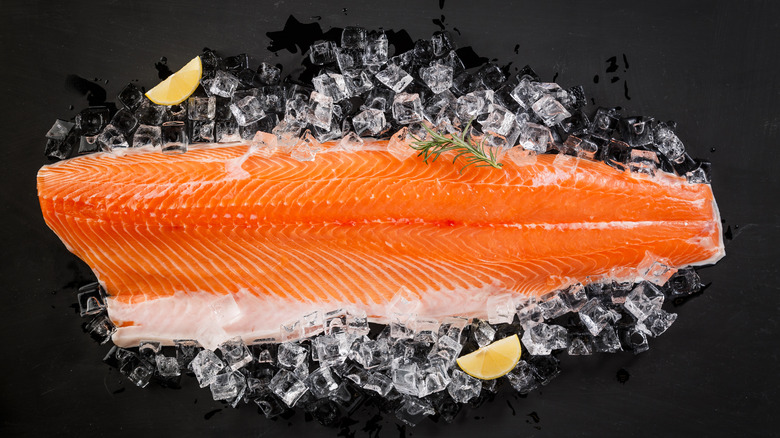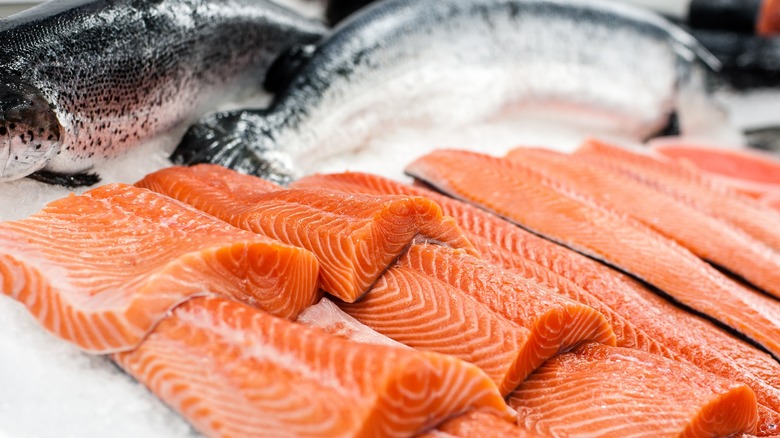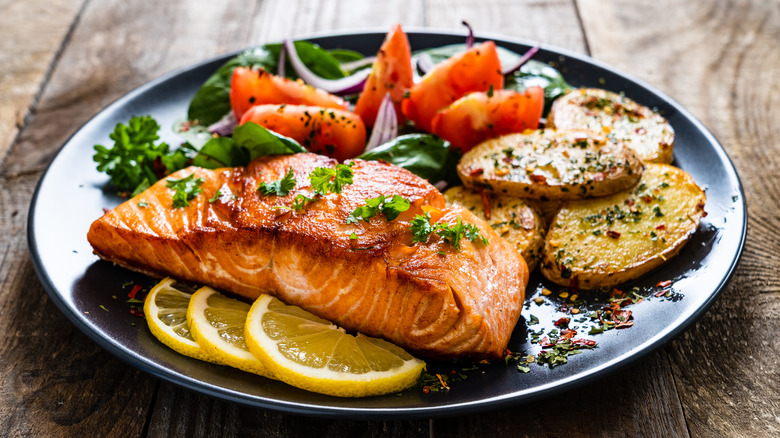The Odd Way Salmon Farmers Achieve Perfectly Pink Fish
Amongst the bounty of seafood deliciousness fished from oceans, rivers, seas, lakes, and bays, the most prized catch in the United States remains the brilliantly pink/orange/red-hued salmon. With about 450,000 tons of the fish landing on dinner plates across America every year, the industry has become more nuanced since Native inhabitants developed sustainable net and hook-and-line methods for feeding their large communities. Today, our salmon supply ranges from wild-caught Alaskan king salmon to sockeye, coho, Copper River salmon, and other various Pacific and Atlantic species.
Then there's the growing popularity of farm-raised salmon, which now accounts for as much as 70% of global production. Some consumers have strong preferences for wild-caught over farm-raised, or vice versa, leading to a lot of label-watching in grocery stores. It's otherwise very difficult to tell the difference between wild or farmed salmon since they both look the same — even though one naturally lacks the fish's characteristic reddish-orange or pink flesh.
Farmed salmon flesh is actually traditionally white, beige-toned, or sometimes gray. But, the reason consumers can't use always color as a distinguishing marker between the two is that salmon farmers colorize the flesh to match the desirable, vibrant pinks and oranges existing naturally in wild-caught salmon. And they do it by adding something called carotenoids to the salmon's food.
Salmon are what they eat
Since farmed salmon live in water-based "pens" or cages, rather than roaming freely in the ocean like wild salmon, they eat different feed, which results in the more dull color of their flesh. On the other hand, their wild Alaskan counterparts, accounting for the vast majority of wild-caught salmon, naturally develop the vibrant pink or orange coloring because they feed on high volumes of shrimp and krill. Since it's the coloring that largely defines salmon for consumers, fish farmers feel a need to mimic the reddish hues through other means in order to make their product just as attractive.
To do so, they use carotenoid plant pigments as part of the farmed salmon's food chain. These pigments occur naturally in crustaceans, which some aquatic farmers crush and use for the coloring, though synthetic, lab-created forms are also available. Other fish farms utilize algae for the necessary coloring compounds. The specific carotenoid that's being added, or synthesized, is typically astaxanthin, which is often fed to the fish in pellet form.
Though color is a primary motivation for adding astaxanthin compounds, it's worth noting that this and other carotenoids do contain valuable vitamins and antioxidants. This is a potential, though not guaranteed, benefit to anyone who subsequently consumes the fish.
The benefits of color-boosting carotenoids
Carotenoids also exist outside the world of colorful fish flesh. At least 600 of these pigments occur in nature, giving many fruits and vegetables their yellow, orange, and red hues, including carrots, pumpkins, apricots, tomatoes, and countless others. They're also what make flamingos appear pink, due to the brine shrimp and algae that comprises much of the animal's diet — it's the same reason why salmon showcase such striking colors.
The carotenoids in wild salmon may carry benefits for human health, too, including antioxidants and properties that could help ward off cancer, boost the immune system, and potentially prevent cardiovascular disease, notes Live Science. As for the asthaxanthin carotenoids added to farmed-salmon feed, aquatic farmers often note the health benefits for the fish as well as for humans who consume them. But it can be a controversial topic due to other added ingredients in the feed, as well as the practice of using synthetic petrochemical versions of asthaxanthin.
Regardless of where you fall in the wild-versus-farmed camp, salmon is overall one of the healthiest, tastiest, and most brilliantly colorful kinds of fish to grace your table. With myriad preparation and cooking methods to try, it's easy to tap into Mother Nature's carotenoid treasure chest.



